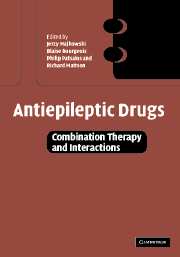Book contents
Foreword
Published online by Cambridge University Press: 07 September 2009
Summary
Drug interactions may be regarded as a stimulating challenge by the pharmacologist but by the physician responsible for management of the patient, interactions are often considered cumbersome and a vexing factor complicating treatment. Drug interactions are particularly common in the treatment of patients with epilepsy. Although monotherapy has been the favoured treatment strategy for the last 25 years or so, up to 50% may not achieve satisfactory seizure control while on the first drug they have been prescribed. A high proportion of these patients will eventually end up taking a combination of different antiepileptic drugs. Until now, the selection of drug combinations has more often been the result of chance or the physician's individual preferences rather than being rational or evidence-based. Given the long duration of epilepsy treatment, most patients will frequently be prescribed drugs for other conditions too. Conventional antiepileptic drugs have been among the most prone to pharmacokinetic interactions, and pharmacodynamic interactions occur whenever two drugs are used together. For all these reasons, the topic of combination therapy and drug interactions is of great importance and up-to-date knowledge is an essential basis for a rational approach to the pharmacological treatment of people with epilepsy.
The editors of the current book on Antiepileptic drugs: combination therapy and interactions have managed to gather an international group of experts to cover these and related issues in a comprehensive volume.
- Type
- Chapter
- Information
- Antiepileptic DrugsCombination Therapy and Interactions, pp. xv - xviPublisher: Cambridge University PressPrint publication year: 2005



